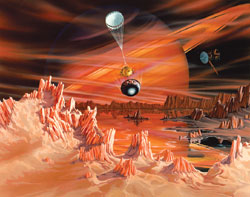What's new in exploration
New Valhall seismic source? A viable seafloor seismic source has been proposed for at least the past 15 years. Several experiments have been conducted during that time, all of which proved the concept. Problems occur with hardgrounds, a rugose seafloor, deepwater depths and the associated problems with positioning and energy transfer to the source, and the time and cost of the procedure.
The benefits include superior energy transfer to the subsurface, elimination of multiples and ghosts caused by reverberations between the seafloor and sea surface, and the generation of strong shear waves – even polarized shear waves.
The pictures on this page show two of these sources. The yellow (two-tube) one has been built in partnership with Schlumberger, and was tested at Schlumberger's Rosharon (Houston) facility. The latest design is the four-tube drawing shown in grey. It offers several advantages in positioning that the previous design did not. Unlike earlier seafloor vibroseis sources, these devices are essentially airguns in a tube. The maker, Bolt Technology, says that there has been considerable interest, particularly in the new design. The title is more of a suggestion, hence the question mark. While writing the Valhall seismic story in this issue – the world's first serious permanent seafloor seismic installation, enabling 4D on demand – I was reminded of this new effort in seafloor sources. Valhall might be the ideal candidate for the new technology, given its need for robust shear sources to image through a gas cloud, the potential for improved resolution, and the relatively shallow 200-ft water, not to mention mitigation of marine mammal issues – and of course, the leadership that BP has shown in trying out new technologies. Other-world oil. For half a century, scientists from the former Soviet Union have believed that some of the petroleum produced from fields in the FSU was generated by abiogenic (non biological) processes. The Russians have used this concept as an exploration strategy and have successfully discovered petroleum fields of which a number of these fields produce either partly or entirely from crystalline basement. There are several abiogenic processes that can generate hydrocarbons. An excellent paper by B. S. Lollar, et al., ( Nature, April 4, 2002) puts a low, non-commercial limit on these abiogenic hydrocarbons. The reason I mention the foregoing is partly because of the upcoming AAPG Hedburg conference in Vienna, where many of the world's authorities on the subject of the origins of oil are going to meet in June to discuss and debate the topic. But mostly it's because the Cassini mission is getting close to its goal, which, for many folks, is how did the hydrocarbons on Saturn's moon Titan originate, and does it have hydrocarbon oceans? Cassini is the last of NASA's Great Observatory series. It is a very large spacecraft, weighing 6.5 tons. It was launched in October 1997, flew to Venus for a gravity-assisted speed boost, back to Earth for another boost, back to Venus, then to Jupiter, and finally on to Saturn, all so that it could make the two billion mile journey in the remarkably short time of just seven years. It will be starting its four-year residence around Saturn beginning in July. On Christmas day, Cassini will eject the European Space Agency's probe, Huygens, which will parachute 22 days later into the thick atmosphere of Titan. After a two hour descent, it will either splash down into a hydrocarbon ocean or hit hard ground at 12 mph. Or something completely different, since we've never seen its surface. Thick, organic-molecule-rich clouds obscure visual observations, except that defined areas of light and dark were recently discovered. Whether these are oceans and land masses is not known. However, earth-based radar telescopes recently penetrated Titan's atmosphere. The data was the first good evidence that it might have hydrocarbon oceans, which agrees with some models. Although a moon, Titan is larger than some planets and is thought to have an atmosphere similar to Earth's early days.
Big find. British oil company Cairn Energy had a big oil discovery in western India. At this point, everything is very tentative. Cairn said the find ranged from 450 – 1,100 million bbl oil in place, with 50 – 200 million bbl recoverable. The discovery well tested 24° – 29° API oil at a combined 6,000 bopd from three zones. The new field lies about 400 mi southwest of New Delhi. This rendition shows the Huygens probe as it is about to splash-down in a hydrocarbon ocean. The Cassini spacecraft is at top right. Saturn is seen in the background through Titan's thick atmosphere of methane, ethane and nitrogen. Art by Craig Attebery.
|
|||||||||||||
- Quantum computing and subsurface prediction (January 2024)
- Mixed outlook for activity on the UK Continental Shelf (December 2023)
- Machine learning-assisted induced seismicity characterization of the Ellenburger formation, Midland basin (August 2023)
- What's new in exploration (March 2023)
- Seismic and its contribution to the energy transition (January 2023)
- First Oil: Sorting through the muddled mess (November 2022)
- Applying ultra-deep LWD resistivity technology successfully in a SAGD operation (May 2019)
- Adoption of wireless intelligent completions advances (May 2019)
- Majors double down as takeaway crunch eases (April 2019)
- What’s new in well logging and formation evaluation (April 2019)
- Qualification of a 20,000-psi subsea BOP: A collaborative approach (February 2019)
- ConocoPhillips’ Greg Leveille sees rapid trajectory of technical advancement continuing (February 2019)







